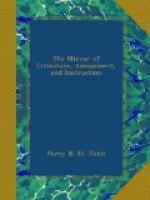I dinna ken what course to steer,
I’m sae to dool an’
daftness driven,
For are so lovely, sweet, and dear,
Sure never breath’d
the breeze o’ heaven;
O there’s a soul beams in her ee,
Ae blink o’t maks are’s
spirit gladder,
And ay the mair she geeks at me,
It pits me aye in love the
madder.
Love winna heal, it winna thole,
You canna shun’t even
when you fear it;
An’ O, this sickness o’ the
soul,
’Tis past the power
of man to bear it!
And yet to mak o’ her a wife,
I couldna square it wi’
my duty,
I’d like to see her a’ her
life
Remain a virgin in her beauty;
As pure as bonny as she’s now,
The walks of human life adorning;
As blithe as bird upon the bough,
As sweet as breeze of summer
morning.
Love paints the earth, it paints the sky,
An’ tints each lovely
hue of Nature,
And makes to the enchanted eye
An angel of a mortal creature.
Blackwood’s Magazine.
* * * * *
Spirit of Discovery.
* * * * *
Regent’s Park.
It is much to be regretted that those who first designed the plantations of the Regent’s Park seem to have had little or no taste for, or knowledge of, hardy trees and shrubs; otherwise, this park might have been the first arboretum in the world. Instead of the (about) 50 sorts of trees and shrubs which it now exhibits, there might have been all the 3,000 sorts, now so admirably displaying their buds and leaves, and some of them their flowers, in the arboretum of Messrs. Loddiges at Hackney. A walk round that arboretum, at this season, is one of the greatest treats which a botanist can enjoy, and a drive round the Regent’s Park might have been just as interesting. It is not yet too late to supply this defect, and the expense to government would be a mere bagatelle. The Zoological Society in the mean time, might receive contributions of herbaceous plants, and be at the expense of planting and naming them.—London’s Mag.
Zoological Society.
A catalogue of the members has been published, which includes 1,291 names, besides corresponding members. The museum in Bruton Street has received, and is daily receiving, valuable additions, as is the garden in the Regent’s Park. The extent of this garden has been, in consequence of the various donations and purchases, considerably increased, and several neat and appropriate structures are now erecting for the abode of different specimens. It is a gratifying circumstance that these specimens are, for the most part, clearly and distinctly named, with the native country of the animal added. We could wish to see a greater variety of trees, shrubs, and herbaceous plants introduced, and equally clear names and geographical indications placed at them also. Why should it not, as far as practicable, be a botanic garden as well as a zoological garden?—Ibid.




